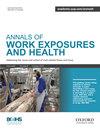95 Standardised Measurement of Equipment Particulate Airborne Concentration (SMEPAC) monitoring
IF 1.8
4区 医学
Q3 PUBLIC, ENVIRONMENTAL & OCCUPATIONAL HEALTH
引用次数: 0
Abstract
What is Standardised Measurement of Equipment Particulate Airborne Concentration (SMEPAC) monitoring? Who does SMEPAC monitoring? How is it done and what do I need to know about SMEPAC monitoring? The fundamental principles you need to be aware of when dealing with SMEPAC monitoring. When new equipment is installed in pharmaceutical industries an APCPPE-test (Assessing the Particulate Containment Performance of Pharmaceutical Equipment) should be performed to collect knowledge about the exposure profile of the equipment. This was formerly known as SMEPAC-test and the name is still commonly known and used, although the ISPE guideline (International Society for Pharmaceutical Engineering) was edited to APCPPE long ago. The above raised questions will be discussed in the presentation. Strategy and method for exposure monitoring will be laid out at an example for pharmaceutical equipment. The theoretical approach of APCPPE-testing will be complemented with experiences from practice as “lessons learned” and conclude with the assessment of the results and the pass/fail decision making.95 设备空气微粒浓度标准化测量(SMEPAC)监测
什么是设备空气微粒浓度标准化测量(SMEPAC)监测?谁来进行 SMEPAC 监测?如何进行 SMEPAC 监测?处理 SMEPAC 监测时需要注意的基本原则。在制药行业安装新设备时,应进行 APCPPE 测试(评估制药设备的微粒封闭性能),以收集有关设备暴露概况的知识。这项测试以前称为 SMEPAC-测试,尽管 ISPE 准则(国际制药工程学会)早已改为 APCPPE-测试,但这一名称仍然广为人知并被广泛使用。演讲中将讨论上述提出的问题。将以制药设备为例,介绍暴露监测的策略和方法。作为 "经验教训",APCPPE 测试的理论方法将得到实践经验的补充,并以结果评估和合格/不合格决策作为结束。
本文章由计算机程序翻译,如有差异,请以英文原文为准。
求助全文
约1分钟内获得全文
求助全文
来源期刊

Annals Of Work Exposures and Health
Medicine-Public Health, Environmental and Occupational Health
CiteScore
4.60
自引率
19.20%
发文量
79
期刊介绍:
About the Journal
Annals of Work Exposures and Health is dedicated to presenting advances in exposure science supporting the recognition, quantification, and control of exposures at work, and epidemiological studies on their effects on human health and well-being. A key question we apply to submission is, "Is this paper going to help readers better understand, quantify, and control conditions at work that adversely or positively affect health and well-being?"
We are interested in high quality scientific research addressing:
the quantification of work exposures, including chemical, biological, physical, biomechanical, and psychosocial, and the elements of work organization giving rise to such exposures;
the relationship between these exposures and the acute and chronic health consequences for those exposed and their families and communities;
populations at special risk of work-related exposures including women, under-represented minorities, immigrants, and other vulnerable groups such as temporary, contingent and informal sector workers;
the effectiveness of interventions addressing exposure and risk including production technologies, work process engineering, and personal protective systems;
policies and management approaches to reduce risk and improve health and well-being among workers, their families or communities;
methodologies and mechanisms that underlie the quantification and/or control of exposure and risk.
There is heavy pressure on space in the journal, and the above interests mean that we do not usually publish papers that simply report local conditions without generalizable results. We are also unlikely to publish reports on human health and well-being without information on the work exposure characteristics giving rise to the effects. We particularly welcome contributions from scientists based in, or addressing conditions in, developing economies that fall within the above scope.
 求助内容:
求助内容: 应助结果提醒方式:
应助结果提醒方式:


